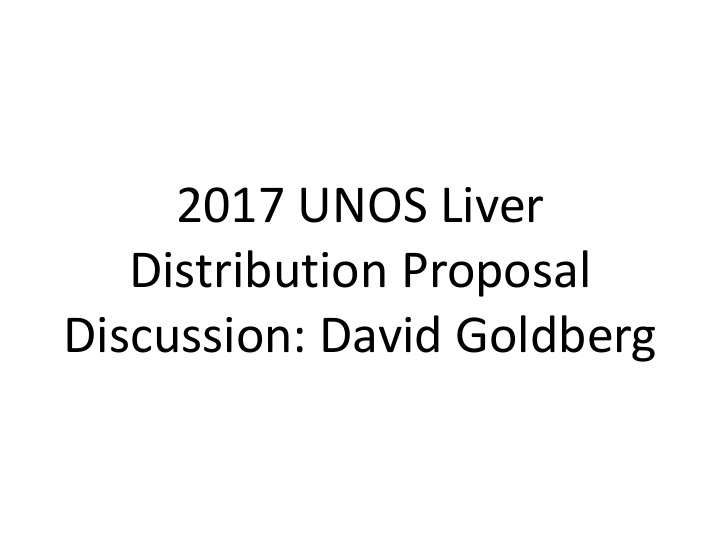



2017 UNOS Liver Distribution Proposal Discussion: David Goldberg
Who am I? • Transplant hepatologist at the University of Pennsylvania • Medical Director of Living Donor Liver Transplant • NIH-funded epidemiologist and health services researcher • Research areas – Organ allocation – Geographic disparities in access to hepatology and liver transplant care – Organ donation and utilization • Close friend to several liver transplant recipients in my own personal life
Why am I a vocal opponent of the current proposal (and prior proposals) • Concerns about choice of disparity metric • Concerns that organs move from areas of higher waitlist mortality to lower waitlist mortality • Concerns about increased costs which will be passed on to transplant centers which will place smaller centers, rural centers, and centers with many Medicaid patients in certain states at financial risk • Concerns that increased travel places surgeons and OPO staff at risk • Concerns about lack of considering about variable organ donation rates • Concerns about lack of increase in transplant nationally • Concerns about external political influences
What is the problem as defined by the Liver & Intestine Committee • HRSA mandate to fix geographic disparities in access to transplant • Liver Committee problem – Median MELD at transplant by DSA ranged from 20 to 40, which equates to an estimated risk of 3- month mortality without a liver transplant of 11% to nearly 100%. • Goal: Normalize median match MELD at transplant across the US
Facts about problem • Median MELD at transplant includes either the calculated MELD scores or the score with exception points – Variable use of exception points: 50% in Region 9 vs 30% in Region 2 – Exception points akin to grade inflation — patients look sicker • Allocation MELD at transplant never been shown to be a marker of severity of illness or risk of mortality – Only lab score predicts mortality – Not correct to say that median allocation MELD scores translate to mortality rates of 11-100%--these numbers would have to be based on lab MELD scores
Facts about problem • Fact: Allocation MELD scores higher in certain parts of the country (i.e., Regions 5 and 9) – This unequivocally does not mean patients transplanted in areas of higher allocation MELD are sicker – SRTR data of 90-day risk of mortality for patients with an allocation MELD score of 25-40 Region 1: 8.6% Region 2: 8.6% Region 3: 7.8% Region 4: 8.1% Region 5: 6.1% Region 6: 6.2% Region 7: 6.9% Region 8: 6.1% Region 9: 6.6% Region 10: 10.8% Region 11: 8.1%
Center practices drive differences in MELD at transplant Median center allocation MELD at transplant for adult DDLTs in 2016 40 Median allocation MELD at transplant 35 30 25 20 1 2 3 4 5 6 7 8 9 10 11 OPTN/UNOS Region
What are appropriate disparity metrics • What matters most to patients and their families: Whether their loved one lives or dies – Proposal ignores waitlist mortality • Other geographic disparities not considered in current proposal – Rural patients (i.e., Appalachia, deep South) – Geographically isolated patients (living far from specialized healthcare)
Major geographic factor not considered in proposal: Organ donation • Organ transplantation is a balance of supply (deceased donor organs) and demand (people in need of a transplant) • Dramatic variability in organ donation rates • Variability at the level of the donor service area (DSA) • Based on differences in: – Community-level engagement in donation – Relationships between local hospitals and organ procurement organizations – Engagement of transplant centers (team members on Boards of OPOs) – OPO performance and organizational structure
Why organ supply lower in major metropolitan areas (LA, NY) • Lower DSA-level donation rates • Suboptimal OPO performance – Demonstrated in several papers • Data demonstrate this is not due to local demographics on a macro level – Many major metropolitan areas with low donation rates in both whites and racial/ethnic minorities • Ignored in all proposals • Hundreds to thousands of more organs available each year if donation rates maximized in largest metropolitan areas
Case study: Number of deceased donors in the Northeast 550 500 450 400 NYRT (NYC) 350 MAOB (New England) PADV (Philadelphia) 300 DSA populations: • NYRT: 13.5 million 250 • MAOB: 11.8 million • PADV: 11.4 million 200 150 2002 2003 2004 2005 2006 2007 2008 2009 2010 2011 2012 2013 2014 2015 2016
Other factor leading to geographic differences in supply: Organ utilization • Geographic variability in use of livers from donation after cardiac death (DCD) donors • 2016 data on deceased donor liver transplant recipients and use of DCD livers – Los Angeles: 1.6% – Philadelphia: 2.3% – New York City: 3.2% – New Orleans: 9.7% – Baltimore: 11.4% – Phoenix/Scottsdale: 24%
What patients should be advocating for (or against) • Need to focus on metrics that matter to patients and providers: mortality • Need to account for rural and underserved populations • Need to ensure centers caring for underserved patients not at risk (provide all liver care) • Need to send message that maximizing organ donation should be primary focus – Improving OPO/DSA performance is the only way to save more lives — most critical in large metropolitan areas with most potential donors – Decreases healthcare costs with increased donation – Need to have better way to measure OPO/DSA performance • Need to ensure maximal utilization of organs to provide more transplants
What will save more lives in major metropolitan areas • New York – Improved organ donation rates – Maximal utilization organ supply (i.e., DCD livers) – Minimizing transplantation of non-residents/non-citizens (transplant tourists) • Los Angeles – Improve organ donation rates (similar number of donors as Philadelphia yet double the population) – Increase utilization of organ supply, specifically DCD livers • In 2016, Mayo Clinic-Scottsdale performed 40 liver transplants from a DCD donor compared to 6 for all of the centers in Los Angeles
Recommend
More recommend